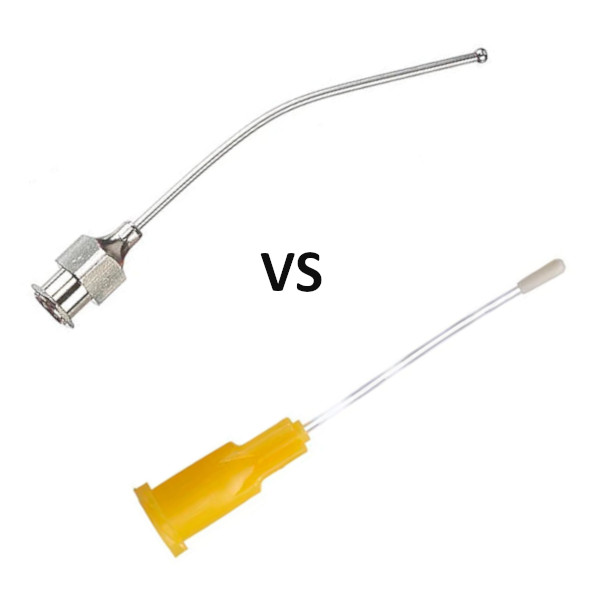Stainless Steel Feeding Needles

Many laboratory animal researchers have trained on and used stainless steel feeding tubes for all of of their careers. Until the early 2000s, the metal tube with a round ball at the end from Popper & Sons, and others that imitated this design, was the only option on the market. Scruff, slide the tube straight down the esophagus, and dose. When you’re done, clean them, sterilize them, and get ready for the next round. Tried and true, they’re reusable, and bite-proof. “That’s how I’ve always done it.”
However, those old standbys don’t come without challenges. Cleaning can be tedious and time consuming, particularly for larger studies. You need to make sure your cleaning procedures are validated, otherwise you risk compound crossover. Metal feeding tubes are notoriously difficult to manufacture, particularly the process of securing the the ball tip to the tube. If the ball falls off during dosing it could be a disaster.
But most importantly, rigid metal tubes can damage the esophagus. A 2016 Vanderbilt study found that 15% of mice dosed daily with metal tubes lost more than 10% of their body weight; autopsies showed esophageal trauma. The authors noted that none of these animals exhibited “abnormal clinical signs during or immediately after gavage” and suggested that “adverse consequences secondary to awake oral gavage are potentially underrecognized and underreported, particularly when concurrent with other study manipulations.” Metal tubes may harm not only animal welfare, but your data as well.
Flexible Plastic Feeding Tubes

Flexible plastic tubes solve most of the issues with metal tubes:
- Gentle – The flexible tube and soft tip reduces the chance of trauma esophagus. As a result, plastic tubes are recommended as an animal welfare refinement (Refining procedures for the administration of substances, Laboratory Animals, 2001, p28).
- Transparent – The tube is clear, allowing you to easily confirm that the test article is delivered.
- Disposable – When you’re done just throw them away — no need to go through the process of cleaning, and there’s no chance of compound crossover.
Our customers have also told us that the training time to become proficient is significantly faster with plastic than metal.
Instech we sell both plastic and stainless tubes, but are biased toward plastic for all these reasons. However, there are downsides. If you are performing oral gavage on a regular basis, you will spend more over time on disposable needles than you will if you reuse. The added equipment cost will be partially offset by reduced cleaning costs, but needs to be justified by improvements in animal welfare and science. The other downside is that, if you are not careful, the animal can bite through the tube.
How to Get Started with Flexible Plastic
Flexible feeding needles sound great, but if you’ve never used them before how do you begin? If you have a trainer, ask them to show you the technique. If you don’t, there are some great resources out there to help you. We’ve put together two oral gavage training videos that are a great place to start:
But what about those of you who are used to stainless steel? Change can be scary and uncomfortable — and as with any new skill, unlearning old habits is often the most difficult part. There is a different technique with flexible plastic that can take some getting used to. Also, to avoid biting of the tube (should you use a bite guard?), you’ll want to slide the tube down the side of the mouth alongside the teeth and not down the center as you may be used to. There is a bit of a learning curve when you make the switch, but once you get the hang of it, you’ll never want to go back.
There you have it. Whether you’re just beginning oral gavage for the first time, or a trusted veteran, flexible plastic feeding tubes are the way forward.
Interested in learning more? Check out this Guide to Oral Gavage for Mice and Rats
Free Samples Available
If you’re curious about flexible feeding tubes but not yet ready to commit, experimenting with a free sample is the way to go. Contact Linton Instrumentation for a free sample to try for yourself and let us know what you think.

